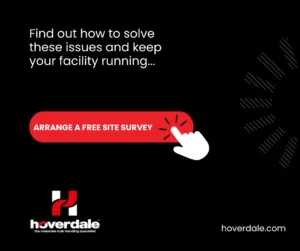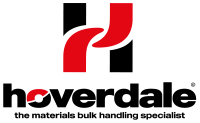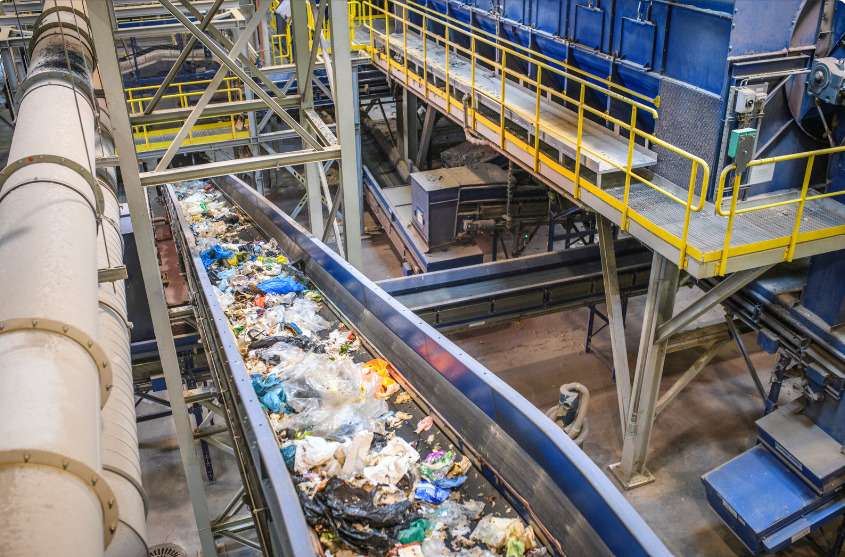Motorised Brush for Conveyor Belts: Keeping chevron and cleated conveyor belts clean at Materials Recycling Plants (MRFs) is essential for several reasons:
Motorised Brush for Cleaning Conveyor Belts:
Prevent Material Contamination: MRFs handle various recyclable materials, including paper, plastic, glass, and metal. If conveyor belts are not kept clean, contaminants such as dirt, dust, or residue from previous materials can accumulate on the belts. This contamination can mix with the recyclables, reducing the quality of the end product and making it harder to separate and process materials effectively.
Maintain Sorting Efficiency: MRFs rely on efficient sorting processes to separate different types of recyclables. When conveyor belts are clean, they function optimally, ensuring a smooth and accurate flow of materials. Dirty belts may result in jams, slow the sorting process, and increase the risk of equipment damage.
Improve Safety: A clean conveyor belt reduces the risk of slip and fall accidents for workers who operate, maintain, or inspect the equipment. Dirty belts can become slippery, making it hazardous to work around them. Regular cleaning can mitigate these safety risks.
Extend Belt Life: Regular cleaning and maintenance of conveyor belts help prolong their lifespan. Dirty belts may experience increased wear and tear, leading to more frequent replacements and higher operating costs. By keeping them clean, you can extend the service life of the belts and reduce the need for costly replacements.
Reduce Downtime: Conveyor belt maintenance and cleaning can be scheduled during planned maintenance shutdowns or downtime, reducing unplanned stoppages. Dirty belts are more likely to experience unexpected breakdowns or require emergency maintenance, leading to production disruptions.
Compliance with Regulations: Environmental regulations often govern the recycling industry, and maintaining clean conveyor belts can help MRPs comply. Clean belts minimise the risk of material contamination, which can lead to fines or penalties for non-compliance.
Enhance Environmental Impact: MRPs are crucial in reducing waste and promoting recycling. Clean conveyor belts contribute to the quality and purity of recycled materials, making them more attractive to manufacturers who use recycled materials in their products. This, in turn, helps reduce the environmental footprint by conserving resources and energy.
“Keeping chevron and cleated conveyor belts clean at Materials Recycling Plants is essential for maintaining efficiency, quality, safety, and compliance while reducing operational costs and environmental impact. Regular cleaning and maintenance are crucial to ensuring the smooth operation of recycling facilities”.
Check out our case study on keeping Chevron and Cleated Conveyor Belts clean here
This Hoverdale client, a large national waste and recycling provider, runs a Material Recovery Facility that processes tonnes of household waste and recovers material for recycling. They were experiencing issues with carryback and spillage of materials. Belly pans were full of material, and various other blockages in the system were causing multiple stoppages.
The build-up of materials on unclean belts causes premature belt wear and damage. In this case, the return rollers were wrapped in material and damaged, and the drive drum motors were overloaded.
The issues caused spillage on the facility floor and gangways, causing a health and safety hazard and requiring frequent additional clean up and resources. When the material becomes airborne, there is a risk of exposing site workers to potential workplace injuries and respiratory diseases.
The main issues were:
- Blockages were causing stoppages.
- Belly pans were full of material that caused belt stoppages.
- The return rollers became wrapped in material & damaged.
- Drive drum motors are overloaded.
- Premature belt wear & damage.
The Hoverdale Solution:
The rubber conveyor belts are cleated and chevron in construction, so conventional-style belt cleaners are unsuitable. A different approach was needed to overcome the belt’s construction and provide effective belt cleaning to prevent carryback and spillage. The Hoverdale Motorised Brush was the ideal solution to tackle this challenge.
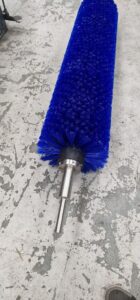
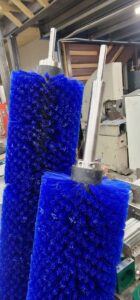
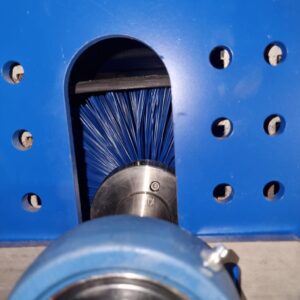
The motorised brush specification includes:
A Stainless Steel construction that auto-adjusts as the brush wears to maintain effective cleaning contact with the belt at all times.
A range of cleaning brush diameters from 200mm O/D to 600mm O/D resulted in cleated belts up to 150mm in height still being cleaned effectively. Quick-release cartridge systems allow fast and easy changeover of brushes.
Results and benefits:
- Carryback was eliminated, and the system avoided blockages
- The return belt and rollers are kept clean and free of material
- No cleaning resource is required to remove material from the facility floor and health and safety risks are reduced
- Belly pans are kept clean and free of material
- Reduced downtime and increased uptime
- The client was able to maintain stable production
- Reduced wear of conveyor belts and rollers, which reduces ongoing costs
- Minimal maintenance is required.
Book a FREE SITE SURVEY today:
